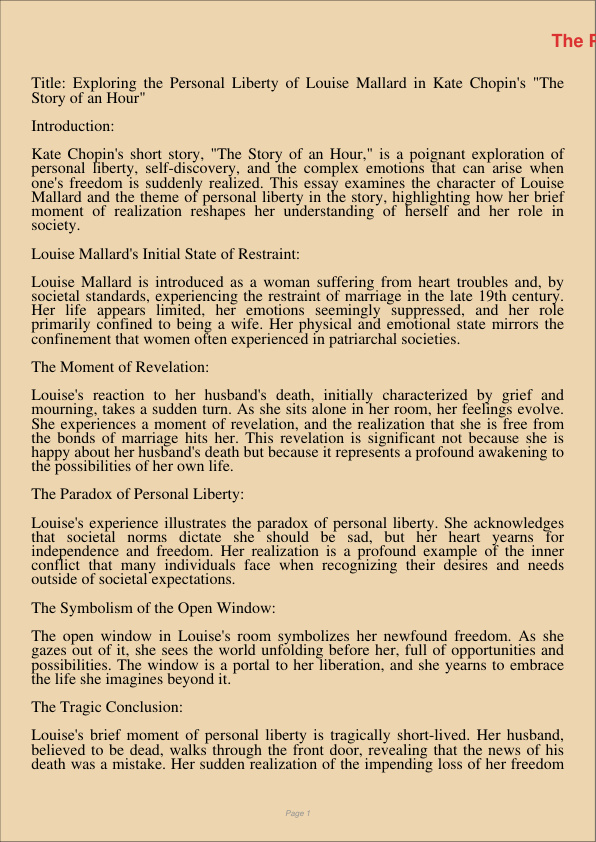The Personal Liberty Of Louise Mallard In Kate ChopinS The Story Of An Hour
Jan 7, 2024
personal liberty
louise mallard
English
Geography

Title: Exploring the Personal Liberty of Louise Mallard in Kate Chopin’s “The Story of an Hour”
Introduction:
Kate Chopin’s short story, “The Story of an Hour,” is a poignant exploration of personal liberty, self-discovery, and the complex emotions that can arise when one’s freedom is suddenly realized. This essay examines the character of Louise Mallard and the theme of personal liberty in the story, highlighting how her brief moment of realization reshapes her understanding of herself and her role in society.
Louise Mallard’s Initial State of Restraint:
Louise Mallard is introduced as a woman suffering from heart troubles and, by societal standards, experiencing the restraint of marriage in the late 19th century. Her life appears limited, her emotions seemingly suppressed, and her role primarily confined to being a wife. Her physical and emotional state mirrors the confinement that women often experienced in patriarchal societies.
The Moment of Revelation:
Louise’s reaction to her husband’s death, initially characterized by grief and mourning, takes a sudden turn. As she sits alone in her room, her feelings evolve. She experiences a moment of revelation, and the realization that she is free from the bonds of marriage hits her. This revelation is significant not because she is happy about her husband’s death but because it represents a profound awakening to the possibilities of her own life.
The Paradox of Personal Liberty:
Louise’s experience illustrates the paradox of personal liberty. She acknowledges that societal norms dictate she should be sad, but her heart yearns for independence and freedom. Her realization is a profound example of the inner conflict that many individuals face when recognizing their desires and needs outside of societal expectations.
The Symbolism of the Open Window:
The open window in Louise’s room symbolizes her newfound freedom. As she gazes out of it, she sees the world unfolding before her, full of opportunities and possibilities. The window is a portal to her liberation, and she yearns to embrace the life she imagines beyond it.
The Tragic Conclusion:
Louise’s brief moment of personal liberty is tragically short-lived. Her husband, believed to be dead, walks through the front door, revealing that the news of his death was a mistake. Her sudden realization of the impending loss of her freedom is so overwhelming that it leads to her untimely death. This turn of events underscores the societal constraints that existed during her time, ultimately extinguishing her newfound spark of liberty.
Conclusion:
Kate Chopin’s “The Story of an Hour” delves into the theme of personal liberty through the character of Louise Mallard. Her brief taste of freedom, although ultimately thwarted, highlights the inner struggles that individuals, particularly women in patriarchal societies, faced when trying to reconcile their desires with societal expectations. Louise’s story serves as a reminder of the importance of individual autonomy and self-discovery, even in the face of societal constraints. While her realization was tragically short-lived, it is a testament to the enduring desire for personal liberty and self-fulfillment that continues to resonate with readers today.